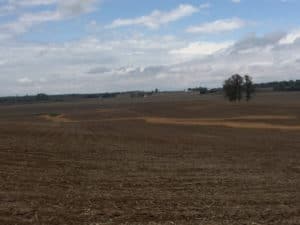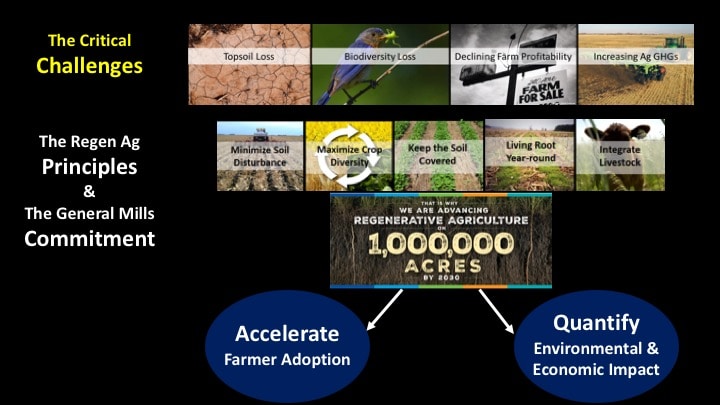 Traveling 1,100 miles over 16 hours and six states in one day provides plenty of opportunities to view the landscape along the I-64 and I-70 westward route to Colorado from the passenger side window. For once, I did just that on a recent road trip. The temptation of burying my head in a newspaper or book or checking emails or social media was lessened by thought-provoking podcasts, agricultural-related discussions with my husband, and internal thoughts about how others traveling the same corridor saw the urban and rural landscapes through their eyes.
Traveling 1,100 miles over 16 hours and six states in one day provides plenty of opportunities to view the landscape along the I-64 and I-70 westward route to Colorado from the passenger side window. For once, I did just that on a recent road trip. The temptation of burying my head in a newspaper or book or checking emails or social media was lessened by thought-provoking podcasts, agricultural-related discussions with my husband, and internal thoughts about how others traveling the same corridor saw the urban and rural landscapes through their eyes.
I also wondered if the changing landscapes of cropland to grazing pastures led others to see that soil dictates what grows. Similar to not “seeing the forest for the trees,” often we don’t see the lessons of the land beyond what is visible to the eye, or connect what we see with the terminology we hear or use. For some, the concept of regenerative agriculture is viewed as “new,” while farmers and ranchers may see it as “what’s always been done” for soil health. Is what is old actually new again?
The Core of Our Existence
Agriculture has been at the core of our existence for more than 10,000 years1 but sadly it also has been at the core of our conflicts. Wars (literally and figuratively) have been fought over food for centuries. Today is no different. Over the years, our society’s direct involvement in agriculture has dwindled, while conversations have escalated across the food value chain about sustainable farming practices. This has led to misunderstandings among those of us who grow the food and those of us who just eat it.
When it comes to soil health, farmers and ranchers would say it has always been about the land with continuous improvement as the goal. However, there have been challenges along the way, especially when the desire to farm exceeded the knowledge needed to make it happen. The Dust Bowl of the 1930s in the Great Plains is a reminder that climate, economics and poor soil management can spell disaster for human and soil health. With the loss of topsoil due to native grasslands plowed for crops, coupled with drought and economic disaster, the once productive soil became barren, resulting in a mass exodus of farmers. It was during this dark time that the Soil Conservation Service was created to help farmers and ranchers implement practices to maintain and improve soil quality and the health of their land. Now known as the Natural Resources Conservation Service (NRCS), this division of the U.S. Department of Agriculture (USDA) continues its efforts with a broader emphasis on all natural resources.
It Starts with the Soil

No-till crops in early spring
From an early age, I learned from my father that the success of farming “starts with the soil.” When I was a small child, my parents purchased a 100-acre dairy farm that showed signs of poor soil management practices. From the initial purchase, it was my father’s collaboration with the USDA Soil Conservation Service and Cooperative Extension Service that turned a “run-down” farm into one that was recognized for its restoration of soil and productivity. By the early 1970s, no-till crop production was introduced. That, combined with having dairy cows graze on pasture land during the warm months and use of green manure were all good soil health practices without the fanfare of trendy terms.
So when conversations arise criticizing conventional or mainstream farming practices as leading to the demise of land stewardship, I am quick to point out that previous advances in “mainstream” farming have been the building blocks for today’s innovations and renewed focus on optimal soil health restoration. However, I recognize that today’s realities of a burgeoning global population, continuous loss of available farm and ranch land (especially in the United States) and climate change implications highlight the importance of soil health beyond the farm gate to across the food value chain.
What is Regenerative Agriculture?
Sustainability has been at the forefront of conversations in the food and agriculture space for the past 15 years. But we only moved to the “next level” in 2016, when the United Nations launched the Decade of Nutrition focusing on UN Sustainable Goal 2 for Zero Hunger. It is with this sense of urgency that the focus of regenerative agriculture has moved from perceived “idealistic” farming practice to more mainstream thought.
So, what is regenerative agriculture? According to the USDA, Robert Rodale originally created the term in the 1990s but it was expanded to “regenerative/sustainable agriculture” by the Rodale Institute and Rodale Research Center. 2 Today, the definition may vary depending on the organization or company using the term, but simply put, it is a holistic, principles-based approach to farming and ranching that seeks to strengthen ecosystems and community resilience regardless of whether practices are organic or more conventional. The Rodale Institute principal-based approach is organic based.
Gabe Brown, one of today’s leading regenerative agriculture advocates, defines the five principles of soil health in his book Dirt to Soil.3 Ray Archuleta, a retired soil health specialist at the USDA NRCS and owner of the Soil Health Academy, describes similar principles in a February issue of the “mainstream” publication Progressive Farmer 4 without mentioning the term “regenerative agriculture.” Regardless of the terminology, the principles from Brown and Archuleta are essentially the same:
1. Limited Disturbance (Brown) / Do Not Disturb (Archuleta) – Limit mechanical, chemical and physical disturbance of the soil to prevent erosion and improve water filtration. “Natural systems don’t invert or till themselves,” as Archuleta says.
2. Armor (Brown) / Give the Soil Some Skin (Archuleta) – The use of cover crops keeps soil covered continuously and regenerates microorganisms of the soil. Cover crops also protect soil from wind and water erosion, suppress weeds and help retain moisture.
3. Diversity (Brown) / Synergize Cover Crops with Crop Rotations (Archuleta) – Increase diversity of plant and animal species similar to nature for improved ecosystem function. Diversity breaks up disease cycles and delays pest resistance.
4. Living Roots (Brown) / Grow a Living Root in the Soil 24/7 (Archuleta) – Keep living roots in the soil as long as possible to feed the fungi and bacteria in the soil. Roots are the pathway for feeding the soil.
5. Integrate Animals and Livestock (Brown & Archuleta) – Animals provide multiple benefits to farmers and ranchers, including economic resiliency, the addition of carbon to the soil through grazing, and the availability of manure to build a healthy and living soil structure. As Brown states, “nature does not function without animals.”
So, the reality is, regardless of how soil health principles are labeled, the commitment to the soil is the same. However, the journey to reach the final destination will be determined by economic and environmental constraints faced by each farmer and rancher.
Understanding Basic Realities — Building Collaborations, Not Conflicts
Agriculture, like human health, is a highly complex system and there is not a “one size fits all” solution. With over 20,000 soil types (and most fields have multiple types), climate differences and changing economics, production practices will vary. It’s about finding the best solution for the climate and growing season that provide a return on investment.
For our own crop land, we are not a fully regenerative agriculture system but we embrace the principles. Currently, over 80% of crop land is no-till with the remaining minimal tillage, and a poultry manure compost is used for fertilizer. Even though cover crops are not currently used on the production acres, we do maintain warm season grass barriers between production ground and waterways to prevent erosion and run-off. Even though no-till is more widely used in our region, soil type and climate will dictate adoption as sandy soils of the coastal areas or colder climates may not achieve desired outcomes. Though cover crops are deemed beneficial to building organic soil matter, some studies, like one from Nebraska, conclude that “moderate cover crop grazing under no-till management can have small or no effects on soil properties and crop yields in the short term.” 5 Likewise, farmers have to evaluate the economic ramifications of producing a cover crop strictly for fertilizer if there are no markets for diverse crops.
For the highly engaged consumer, the topics of responsible farming and land management, and their linkages to regenerative agriculture, are gaining traction, often with the perception that good soil health practices are followed by the few rather than many. 6 “Resistance to change” has become the image of the mainstream farmer and rancher rather than understanding the complexities of each farming situation. In reality, the movement to integrate more regenerative agriculture practices is building based on the convergence of several factors: consumers are interested in products sourced with ingredients that restore rather than deplete soil health; traditional corn and soybean crops are declining in profitability; and there is growing interest in building resiliency within U.S. food systems based on the experiences of the 2020 pandemic.
An excellent example of this convergence within food companies is General Mills’ collaboration with farmers in the Upper Plains to adopt regenerative agriculture practices for the production of one million acres of oats by 2030.
It will take similar collaborations and partnerships across the food value chain to create the outcome we all desire: preserving today’s soil for future generations. We only have a limited supply and implementing the best soil practices are in the best interest for all. Let’s work together!
References:
1. “Stewards of the Land: Harnessing American Agriculture for a Sustainable Future,” Essay by Erin Fitzgerald and Greg Gershuny, A Better Planet: 40 Big Ideas for a Sustainable Future, edited by Daniel C. Etsy, 2019.
2. “Sustainability: An Opportunity for Leadership,” by Robert Rodale, Sustainable Agricultural Systems, edited by Clive A. Edwards, et al. (Ankeny IA: Soil and Water Conservation Society, 1990), pp. 84-85. NAL Call # S494.5 S86S86.
3. Dirt to Soil: One’s Family Journey into Regenerative Agriculture, Gabe Brown, Chelsea Green Publishing, VT. 2018.
4. “Listen to the Land” Special Issue, Progressive Farmer, February 2020.
5. “Crop Grazing: Impacts on Soils and Crop Yields,” Cropwatch, January 22, 2019.
6. “What’s Beyond Organic? Regenerative Agriculture and Soil Health May Provide a Glimpse,” Hartman Group, February 4, 2020.

